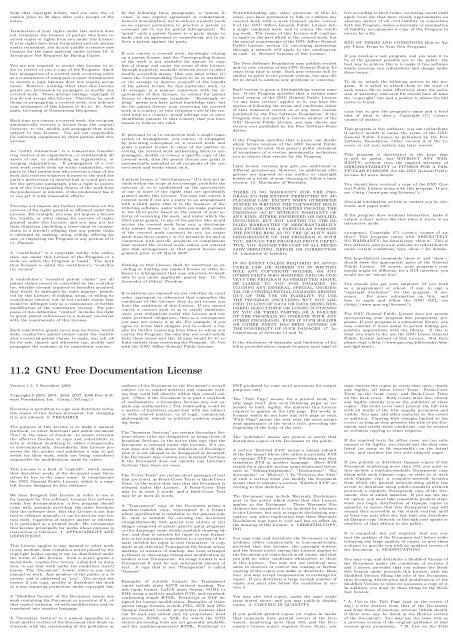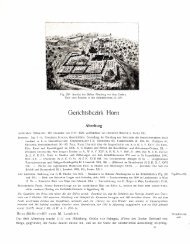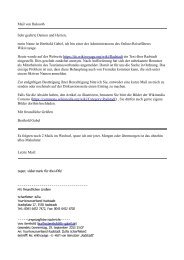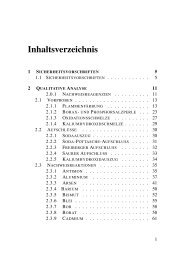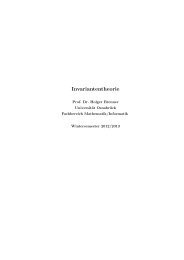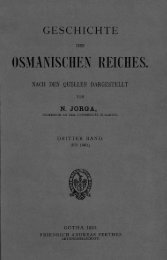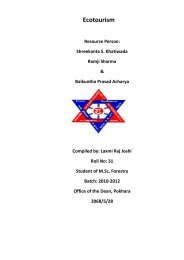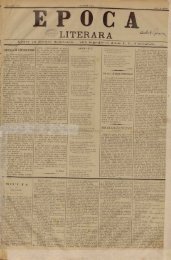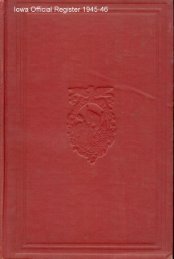Serial Programming - upload.wikimedia....
Serial Programming - upload.wikimedia....
Serial Programming - upload.wikimedia....
You also want an ePaper? Increase the reach of your titles
YUMPU automatically turns print PDFs into web optimized ePapers that Google loves.
from that copyright holder, and you cure the violation<br />
prior to 30 days after your receipt of the<br />
notice.<br />
Termination of your rights under this section does<br />
not terminate the licenses of parties who have received<br />
copies or rights from you under this License.<br />
If your rights have been terminated and not permanently<br />
reinstated, you do not qualify to receive new<br />
licenses for the same material under section 10. 9.<br />
Acceptance Not Required for Having Copies.<br />
You are not required to accept this License in order<br />
to receive or run a copy of the Program. Ancillary<br />
propagation of a covered work occurring solely<br />
as a consequence of using peer-to-peer transmission<br />
to receive a copy likewise does not require acceptance.<br />
However, nothing other than this License<br />
grants you permission to propagate or modify any<br />
covered work. These actions infringe copyright if<br />
you do not accept this License. Therefore, by modifying<br />
or propagating a covered work, you indicate<br />
your acceptance of this License to do so. 10. Automatic<br />
Licensing of Downstream Recipients.<br />
Each time you convey a covered work, the recipient<br />
automatically receives a license from the original<br />
licensors, to run, modify and propagate that work,<br />
subject to this License. You are not responsible<br />
for enforcing compliance by third parties with this<br />
License.<br />
An “entity transaction” is a transaction transferring<br />
control of an organization, or substantially all<br />
assets of one, or subdividing an organization, or<br />
merging organizations. If propagation of a covered<br />
work results from an entity transaction, each<br />
party to that transaction who receives a copy of the<br />
work also receives whatever licenses to the work the<br />
party’s predecessor in interest had or could give under<br />
the previous paragraph, plus a right to possession<br />
of the Corresponding Source of the work from<br />
the predecessor in interest, if the predecessor has it<br />
or can get it with reasonable efforts.<br />
You may not impose any further restrictions on the<br />
exercise of the rights granted or affirmed under this<br />
License. For example, you may not impose a license<br />
fee, royalty, or other charge for exercise of rights<br />
granted under this License, and you may not initiate<br />
litigation (including a cross-claim or counterclaim<br />
in a lawsuit) alleging that any patent claim<br />
is infringed by making, using, selling, offering for<br />
sale, or importing the Program or any portion of it.<br />
11. Patents.<br />
A “contributor” is a copyright holder who authorizes<br />
use under this License of the Program or a<br />
work on which the Program is based. The work<br />
thus licensed is called the contributor’s “contributor<br />
version”.<br />
A contributor’s “essential patent claims” are all<br />
patent claims owned or controlled by the contributor,<br />
whether already acquired or hereafter acquired,<br />
that would be infringed by some manner, permitted<br />
by this License, of making, using, or selling its<br />
contributor version, but do not include claims that<br />
would be infringed only as a consequence of further<br />
modification of the contributor version. For purposes<br />
of this definition, “control” includes the right<br />
to grant patent sublicenses in a manner consistent<br />
with the requirements of this License.<br />
Each contributor grants you a non-exclusive, worldwide,<br />
royalty-free patent license under the contributor’s<br />
essential patent claims, to make, use, sell, offer<br />
for sale, import and otherwise run, modify and<br />
propagate the contents of its contributor version.<br />
In the following three paragraphs, a “patent license”<br />
is any express agreement or commitment,<br />
however denominated, not to enforce a patent (such<br />
as an express permission to practice a patent or<br />
covenant not to sue for patent infringement). To<br />
“grant” such a patent license to a party means to<br />
make such an agreement or commitment not to enforce<br />
a patent against the party.<br />
If you convey a covered work, knowingly relying<br />
on a patent license, and the Corresponding Source<br />
of the work is not available for anyone to copy,<br />
free of charge and under the terms of this License,<br />
through a publicly available network server or other<br />
readily accessible means, then you must either (1)<br />
cause the Corresponding Source to be so available,<br />
or (2) arrange to deprive yourself of the benefit<br />
of the patent license for this particular work, or<br />
(3) arrange, in a manner consistent with the requirements<br />
of this License, to extend the patent<br />
license to downstream recipients. “Knowingly relying”<br />
means you have actual knowledge that, but<br />
for the patent license, your conveying the covered<br />
work in a country, or your recipient’s use of the covered<br />
work in a country, would infringe one or more<br />
identifiable patents in that country that you have<br />
reason to believe are valid.<br />
If, pursuant to or in connection with a single transaction<br />
or arrangement, you convey, or propagate<br />
by procuring conveyance of, a covered work, and<br />
grant a patent license to some of the parties receiving<br />
the covered work authorizing them to use,<br />
propagate, modify or convey a specific copy of the<br />
covered work, then the patent license you grant is<br />
automatically extended to all recipients of the covered<br />
work and works based on it.<br />
A patent license is “discriminatory” if it does not include<br />
within the scope of its coverage, prohibits the<br />
exercise of, or is conditioned on the non-exercise<br />
of one or more of the rights that are specifically<br />
granted under this License. You may not convey a<br />
covered work if you are a party to an arrangement<br />
with a third party that is in the business of distributing<br />
software, under which you make payment<br />
to the third party based on the extent of your activity<br />
of conveying the work, and under which the<br />
third party grants, to any of the parties who would<br />
receive the covered work from you, a discriminatory<br />
patent license (a) in connection with copies<br />
of the covered work conveyed by you (or copies<br />
made from those copies), or (b) primarily for and in<br />
connection with specific products or compilations<br />
that contain the covered work, unless you entered<br />
into that arrangement, or that patent license was<br />
granted, prior to 28 March 2007.<br />
Nothing in this License shall be construed as excluding<br />
or limiting any implied license or other defenses<br />
to infringement that may otherwise be available<br />
to you under applicable patent law. 12. No<br />
Surrender of Others’ Freedom.<br />
If conditions are imposed on you (whether by court<br />
order, agreement or otherwise) that contradict the<br />
conditions of this License, they do not excuse you<br />
from the conditions of this License. If you cannot<br />
convey a covered work so as to satisfy simultaneously<br />
your obligations under this License and any<br />
other pertinent obligations, then as a consequence<br />
you may not convey it at all. For example, if you<br />
agree to terms that obligate you to collect a royalty<br />
for further conveying from those to whom you<br />
convey the Program, the only way you could satisfy<br />
both those terms and this License would be to refrain<br />
entirely from conveying the Program. 13. Use<br />
with the GNU Affero General Public License.<br />
Notwithstanding any other provision of this License,<br />
you have permission to link or combine any<br />
covered work with a work licensed under version<br />
3 of the GNU Affero General Public License into<br />
a single combined work, and to convey the resulting<br />
work. The terms of this License will continue<br />
to apply to the part which is the covered work, but<br />
the special requirements of the GNU Affero General<br />
Public License, section 13, concerning interaction<br />
through a network will apply to the combination<br />
as such. 14. Revised Versions of this License.<br />
The Free Software Foundation may publish revised<br />
and/or new versions of the GNU General Public License<br />
from time to time. Such new versions will be<br />
similar in spirit to the present version, but may differ<br />
in detail to address new problems or concerns.<br />
Each version is given a distinguishing version number.<br />
If the Program specifies that a certain numbered<br />
version of the GNU General Public License<br />
“or any later version” applies to it, you have the<br />
option of following the terms and conditions either<br />
of that numbered version or of any later version<br />
published by the Free Software Foundation. If the<br />
Program does not specify a version number of the<br />
GNU General Public License, you may choose any<br />
version ever published by the Free Software Foundation.<br />
If the Program specifies that a proxy can decide<br />
which future versions of the GNU General Public<br />
License can be used, that proxy’s public statement<br />
of acceptance of a version permanently authorizes<br />
you to choose that version for the Program.<br />
Later license versions may give you additional or<br />
different permissions. However, no additional obligations<br />
are imposed on any author or copyright<br />
holder as a result of your choosing to follow a later<br />
version. 15. Disclaimer of Warranty.<br />
THERE IS NO WARRANTY FOR THE PRO-<br />
GRAM, TO THE EXTENT PERMITTED BY AP-<br />
PLICABLE LAW. EXCEPT WHEN OTHERWISE<br />
STATED IN WRITING THE COPYRIGHT HOLD-<br />
ERS AND/OR OTHER PARTIES PROVIDE THE<br />
PROGRAM “AS IS” WITHOUT WARRANTY OF<br />
ANY KIND, EITHER EXPRESSED OR IMPLIED,<br />
INCLUDING, BUT NOT LIMITED TO, THE IM-<br />
PLIED WARRANTIES OF MERCHANTABILITY<br />
AND FITNESS FOR A PARTICULAR PURPOSE.<br />
THE ENTIRE RISK AS TO THE QUALITY AND<br />
PERFORMANCE OF THE PROGRAM IS WITH<br />
YOU. SHOULD THE PROGRAM PROVE DEFEC-<br />
TIVE, YOU ASSUME THE COST OF ALL NECES-<br />
SARY SERVICING, REPAIR OR CORRECTION.<br />
16. Limitation of Liability.<br />
IN NO EVENT UNLESS REQUIRED BY APPLI-<br />
CABLE LAW OR AGREED TO IN WRITING<br />
WILL ANY COPYRIGHT HOLDER, OR ANY<br />
OTHER PARTY WHO MODIFIES AND/OR CON-<br />
VEYS THE PROGRAM AS PERMITTED ABOVE,<br />
BE LIABLE TO YOU FOR DAMAGES, IN-<br />
CLUDING ANY GENERAL, SPECIAL, INCIDEN-<br />
TAL OR CONSEQUENTIAL DAMAGES ARISING<br />
OUT OF THE USE OR INABILITY TO USE<br />
THE PROGRAM (INCLUDING BUT NOT LIM-<br />
ITED TO LOSS OF DATA OR DATA BEING REN-<br />
DERED INACCURATE OR LOSSES SUSTAINED<br />
BY YOU OR THIRD PARTIES OR A FAILURE<br />
OF THE PROGRAM TO OPERATE WITH ANY<br />
OTHER PROGRAMS), EVEN IF SUCH HOLDER<br />
OR OTHER PARTY HAS BEEN ADVISED OF<br />
THE POSSIBILITY OF SUCH DAMAGES. 17. Interpretation<br />
of Sections 15 and 16.<br />
If the disclaimer of warranty and limitation of liability<br />
provided above cannot be given local legal effect<br />
according to their terms, reviewing courts shall<br />
apply local law that most closely approximates an<br />
absolute waiver of all civil liability in connection<br />
with the Program, unless a warranty or assumption<br />
of liability accompanies a copy of the Program in<br />
return for a fee.<br />
END OF TERMS AND CONDITIONS How to Apply<br />
These Terms to Your New Programs<br />
If you develop a new program, and you want it to<br />
be of the greatest possible use to the public, the<br />
best way to achieve this is to make it free software<br />
which everyone can redistribute and change under<br />
these terms.<br />
To do so, attach the following notices to the program.<br />
It is safest to attach them to the start of<br />
each source file to most effectively state the exclusion<br />
of warranty; and each file should have at least<br />
the “copyright” line and a pointer to where the full<br />
notice is found.<br />
Copyright (C) <br />
<br />
This program is free software: you can redistribute<br />
it and/or modify it under the terms of the GNU<br />
General Public License as published by the Free<br />
Software Foundation, either version 3 of the License,<br />
or (at your option) any later version.<br />
This program is distributed in the hope that<br />
it will be useful, but WITHOUT ANY WAR-<br />
RANTY; without even the implied warranty of<br />
MERCHANTABILITY or FITNESS FOR A PAR-<br />
TICULAR PURPOSE. See the GNU General Public<br />
License for more details.<br />
You should have received a copy of the GNU General<br />
Public License along with this program. If not,<br />
see .<br />
Also add information on how to contact you by electronic<br />
and paper mail.<br />
If the program does terminal interaction, make it<br />
output a short notice like this when it starts in an<br />
interactive mode:<br />
Copyright (C) <br />
This program comes with ABSOLUTELY<br />
NO WARRANTY; for details type ‘show w’. This is<br />
free software, and you are welcome to redistribute it<br />
under certain conditions; type ‘show c’ for details.<br />
The hypothetical commands ‘show w’ and ‘show c’<br />
should show the appropriate parts of the General<br />
Public License. Of course, your program’s commands<br />
might be different; for a GUI interface, you<br />
would use an “about box”.<br />
You should also get your employer (if you work<br />
as a programmer) or school, if any, to sign a<br />
“copyright disclaimer” for the program, if necessary.<br />
For more information on this, and<br />
how to apply and follow the GNU GPL, see<br />
.<br />
The GNU General Public License does not permit<br />
incorporating your program into proprietary programs.<br />
If your program is a subroutine library, you<br />
may consider it more useful to permit linking proprietary<br />
applications with the library. If this is<br />
what you want to do, use the GNU Lesser General<br />
Public License instead of this License. But first,<br />
please read .<br />
11.2 GNU Free Documentation License<br />
Version 1.3, 3 November 2008<br />
Copyright © 2000, 2001, 2002, 2007, 2008 Free Software<br />
Foundation, Inc. <br />
Everyone is permitted to copy and distribute verbatim<br />
copies of this license document, but changing<br />
it is not allowed. 0. PREAMBLE<br />
The purpose of this License is to make a manual,<br />
textbook, or other functional and useful document<br />
"free" in the sense of freedom: to assure everyone<br />
the effective freedom to copy and redistribute it,<br />
with or without modifying it, either commercially<br />
or noncommercially. Secondarily, this License preserves<br />
for the author and publisher a way to get<br />
credit for their work, while not being considered<br />
responsible for modifications made by others.<br />
This License is a kind of "copyleft", which means<br />
that derivative works of the document must themselves<br />
be free in the same sense. It complements<br />
the GNU General Public License, which is a copyleft<br />
license designed for free software.<br />
We have designed this License in order to use it<br />
for manuals for free software, because free software<br />
needs free documentation: a free program should<br />
come with manuals providing the same freedoms<br />
that the software does. But this License is not limited<br />
to software manuals; it can be used for any textual<br />
work, regardless of subject matter or whether<br />
it is published as a printed book. We recommend<br />
this License principally for works whose purpose is<br />
instruction or reference. 1. APPLICABILITY AND<br />
DEFINITIONS<br />
This License applies to any manual or other work,<br />
in any medium, that contains a notice placed by the<br />
copyright holder saying it can be distributed under<br />
the terms of this License. Such a notice grants a<br />
world-wide, royalty-free license, unlimited in duration,<br />
to use that work under the conditions stated<br />
herein. The "Document", below, refers to any such<br />
manual or work. Any member of the public is a licensee,<br />
and is addressed as "you". You accept the<br />
license if you copy, modify or distribute the work<br />
in a way requiring permission under copyright law.<br />
A "Modified Version" of the Document means any<br />
work containing the Document or a portion of it, either<br />
copied verbatim, or with modifications and/or<br />
translated into another language.<br />
A "Secondary Section" is a named appendix or a<br />
front-matter section of the Document that deals exclusively<br />
with the relationship of the publishers or<br />
authors of the Document to the Document’s overall<br />
subject (or to related matters) and contains nothing<br />
that could fall directly within that overall subject.<br />
(Thus, if the Document is in part a textbook<br />
of mathematics, a Secondary Section may not explain<br />
any mathematics.) The relationship could be<br />
a matter of historical connection with the subject<br />
or with related matters, or of legal, commercial,<br />
philosophical, ethical or political position regarding<br />
them.<br />
The "Invariant Sections" are certain Secondary Sections<br />
whose titles are designated, as being those of<br />
Invariant Sections, in the notice that says that the<br />
Document is released under this License. If a section<br />
does not fit the above definition of Secondary<br />
then it is not allowed to be designated as Invariant.<br />
The Document may contain zero Invariant Sections.<br />
If the Document does not identify any Invariant<br />
Sections then there are none.<br />
The "Cover Texts" are certain short passages of text<br />
that are listed, as Front-Cover Texts or Back-Cover<br />
Texts, in the notice that says that the Document is<br />
released under this License. A Front-Cover Text<br />
may be at most 5 words, and a Back-Cover Text<br />
may be at most 25 words.<br />
A "Transparent" copy of the Document means a<br />
machine-readable copy, represented in a format<br />
whose specification is available to the general public,<br />
that is suitable for revising the document<br />
straightforwardly with generic text editors or (for<br />
images composed of pixels) generic paint programs<br />
or (for drawings) some widely available drawing editor,<br />
and that is suitable for input to text formatters<br />
or for automatic translation to a variety of formats<br />
suitable for input to text formatters. A copy<br />
made in an otherwise Transparent file format whose<br />
markup, or absence of markup, has been arranged<br />
to thwart or discourage subsequent modification by<br />
readers is not Transparent. An image format is not<br />
Transparent if used for any substantial amount of<br />
text. A copy that is not "Transparent" is called<br />
"Opaque".<br />
Examples of suitable formats for Transparent<br />
copies include plain ASCII without markup, Texinfo<br />
input format, LaTeX input format, SGML or<br />
XML using a publicly available DTD, and standardconforming<br />
simple HTML, PostScript or PDF designed<br />
for human modification. Examples of transparent<br />
image formats include PNG, XCF and JPG.<br />
Opaque formats include proprietary formats that<br />
can be read and edited only by proprietary word<br />
processors, SGML or XML for which the DTD<br />
and/or processing tools are not generally available,<br />
and the machine-generated HTML, PostScript or<br />
PDF produced by some word processors for output<br />
purposes only.<br />
The "Title Page" means, for a printed book, the<br />
title page itself, plus such following pages as are<br />
needed to hold, legibly, the material this License<br />
requires to appear in the title page. For works in<br />
formats which do not have any title page as such,<br />
"Title Page" means the text near the most prominent<br />
appearance of the work’s title, preceding the<br />
beginning of the body of the text.<br />
The "publisher" means any person or entity that<br />
distributes copies of the Document to the public.<br />
A section "Entitled XYZ" means a named subunit<br />
of the Document whose title either is precisely XYZ<br />
or contains XYZ in parentheses following text that<br />
translates XYZ in another language. (Here XYZ<br />
stands for a specific section name mentioned below,<br />
such as "Acknowledgements", "Dedications", "Endorsements",<br />
or "History".) To "Preserve the Title"<br />
of such a section when you modify the Document<br />
means that it remains a section "Entitled XYZ" according<br />
to this definition.<br />
The Document may include Warranty Disclaimers<br />
next to the notice which states that this License<br />
applies to the Document. These Warranty Disclaimers<br />
are considered to be included by reference<br />
in this License, but only as regards disclaiming warranties:<br />
any other implication that these Warranty<br />
Disclaimers may have is void and has no effect on<br />
the meaning of this License. 2. VERBATIM COPY-<br />
ING<br />
You may copy and distribute the Document in any<br />
medium, either commercially or noncommercially,<br />
provided that this License, the copyright notices,<br />
and the license notice saying this License applies to<br />
the Document are reproduced in all copies, and that<br />
you add no other conditions whatsoever to those<br />
of this License. You may not use technical measures<br />
to obstruct or control the reading or further<br />
copying of the copies you make or distribute. However,<br />
you may accept compensation in exchange for<br />
copies. If you distribute a large enough number of<br />
copies you must also follow the conditions in section<br />
3.<br />
You may also lend copies, under the same conditions<br />
stated above, and you may publicly display<br />
copies. 3. COPYING IN QUANTITY<br />
If you publish printed copies (or copies in media<br />
that commonly have printed covers) of the Document,<br />
numbering more than 100, and the Document’s<br />
license notice requires Cover Texts, you<br />
must enclose the copies in covers that carry, clearly<br />
and legibly, all these Cover Texts: Front-Cover<br />
Texts on the front cover, and Back-Cover Texts<br />
on the back cover. Both covers must also clearly<br />
and legibly identify you as the publisher of these<br />
copies. The front cover must present the full title<br />
with all words of the title equally prominent and<br />
visible. You may add other material on the covers<br />
in addition. Copying with changes limited to the<br />
covers, as long as they preserve the title of the Document<br />
and satisfy these conditions, can be treated<br />
as verbatim copying in other respects.<br />
If the required texts for either cover are too voluminous<br />
to fit legibly, you should put the first ones<br />
listed (as many as fit reasonably) on the actual<br />
cover, and continue the rest onto adjacent pages.<br />
If you publish or distribute Opaque copies of the<br />
Document numbering more than 100, you must either<br />
include a machine-readable Transparent copy<br />
along with each Opaque copy, or state in or with<br />
each Opaque copy a computer-network location<br />
from which the general network-using public has<br />
access to download using public-standard network<br />
protocols a complete Transparent copy of the Document,<br />
free of added material. If you use the latter<br />
option, you must take reasonably prudent steps,<br />
when you begin distribution of Opaque copies in<br />
quantity, to ensure that this Transparent copy will<br />
remain thus accessible at the stated location until<br />
at least one year after the last time you distribute<br />
an Opaque copy (directly or through your agents or<br />
retailers) of that edition to the public.<br />
It is requested, but not required, that you contact<br />
the authors of the Document well before redistributing<br />
any large number of copies, to give them<br />
a chance to provide you with an updated version of<br />
the Document. 4. MODIFICATIONS<br />
You may copy and distribute a Modified Version of<br />
the Document under the conditions of sections 2<br />
and 3 above, provided that you release the Modified<br />
Version under precisely this License, with the<br />
Modified Version filling the role of the Document,<br />
thus licensing distribution and modification of the<br />
Modified Version to whoever possesses a copy of it.<br />
In addition, you must do these things in the Modified<br />
Version:<br />
* A. Use in the Title Page (and on the covers, if<br />
any) a title distinct from that of the Document,<br />
and from those of previous versions (which should,<br />
if there were any, be listed in the History section<br />
of the Document). You may use the same title as<br />
a previous version if the original publisher of that<br />
version gives permission. * B. List on the Title


